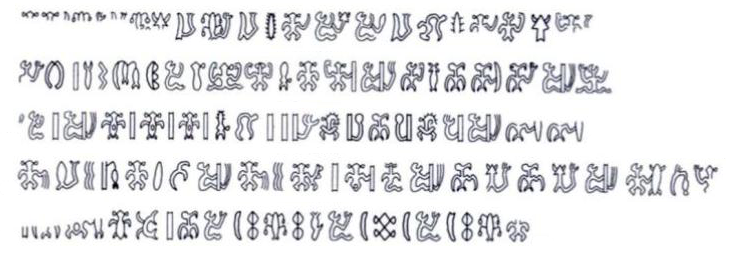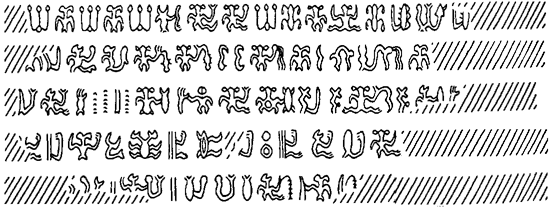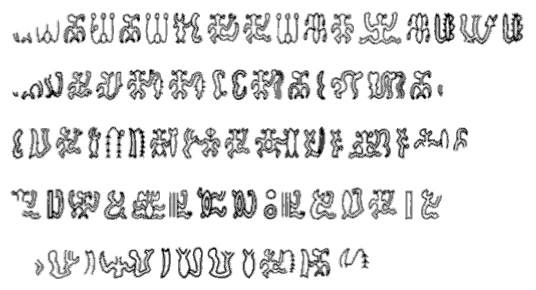
Rongorongo text N
Encyclopedia
.jpg)
Rongorongo
Rongorongo is a system of glyphs discovered in the 19th century on Easter Island that appears to be writing or proto-writing. It cannot be read despite numerous attempts at decipherment. Although some calendrical and what might prove to be genealogical information has been identified, not even...
corpus, the smaller of two tablets in Vienna and therefore also known as the Small Vienna tablet, is one of two dozen surviving rongorongo texts, and repeats much of the verso of tablet E
Rongorongo text E
Text E of the rongorongo corpus, also known as Keiti, is one of two dozen known rongorongo texts, though it survives only in photographs and rubbings.-Other names:E is the standard designation, from Barthel...
.
Other names
N is the standard designation, from BarthelThomas Barthel
Thomas Sylvester Barthel was a German ethnologist and epigrapher who is best known for cataloguing the undeciphered rongorongo script of Easter Island....
(1958). Fischer (1997) refers to it as RR23.
Location
Museum für VölkerkundeVienna Museum of Ethnology
thumb|The Museum of Ethnolog is housed in a wing of the [[Hofburg Imperial Palace]].thumb|InteriorThe Museum of Ethnology in Vienna is the largest anthropological museum in Austria, established in 1876. It currently resides in the Hofburg Imperial Palace and houses a quarter million ethnographical...
, Vienna. Catalog # 22870.
There is a reproduction in the Musée de l'Homme
Musée de l'Homme
The Musée de l'Homme was created in 1937 by Paul Rivet for the 1937 Exposition Internationale des Arts et Techniques dans la Vie Moderne. It is the descendant of the Musée d'Ethnographie du Trocadéro, founded in 1878...
, Paris.
Physical description
Small Vienna is a rectangular piece of Podocarpus latifoliusPodocarpus latifolius
Podocarpus latifolius is a large evergreen tree up to 35 m high and 3 m trunk diameter, in the conifer family Podocarpaceae; it is the type species of the genus Podocarpus....
wood (Orliac 2007), 25.5 × 5.2 × 2 cm, slightly convex but not fluted. It is heavily fire damaged, with one end splintered off, and badly cracked. The surface is corroded, but the glyphs are still legible.
Haberlandt (1886) noticed that N was carved with a different technique than the other tablets. In Fischer's words,
- It appears that the glyphs were incised with a sharpened bone instead of a shark's tooth; this is principally evidenced by the shallowness and width of the contour grooves. It also displays secondary working with obsidian flakes to elaborate details within the finished contour lines. No other rongorongo inscription reveals such graphic extravagance.
Provenance
In 1882 an archaeological expedition aboard the SMS Hyäne visited Easter Island, and captain Wilhelm Geiseler purchased two tablets. The purchase had been arranged by Schlubach, the German consul in ValparaísoValparaíso
Valparaíso is a city and commune of Chile, center of its third largest conurbation and one of the country's most important seaports and an increasing cultural center in the Southwest Pacific hemisphere. The city is the capital of the Valparaíso Province and the Valparaíso Region...
, at the request of Adolf Bastian
Adolf Bastian
Adolf Bastian was a 19th century polymath best remembered for his contributions to the development of ethnography and the development of anthropology as a discipline...
, the director of the Königliches Museum für Völkerkunde in Berlin. The tablets were given to the uncle of Schlubach's wife, Alexander Salmon, Jr
Alexander Salmon, Jr
Alexander Ariipaea Vehiaitipare Salmon Jr. was the English-Jewish-Tahitian co-owner of the Maison Brander plantations on Tahiti and de facto ruler of Easter Island from 1878 till its cession to Chile in 1888.-Family:...
, who then shipped three tablets, M, N, and O, to Schlubach. Several years later, when Schlubach returned to Hamburg, he sent just one of the tablets to Bastian and sold the other two privately to the Hamburg firm "Klée und Kocher". They were then sold to the Austrian Vice-Consul in Hamburg, Heinrich Freiherr von Westenholz, who donated them to Vienna's Museum für Völkerkunde in 1886.
Alexander Salmon, Jr, the manager of the Brander plantations on Easter Island who had transcribed and (poorly) translated the 'readings' that Jaussen
Florentin-Étienne Jaussen
Monsignor Florentin-Étienne Jaussen was the first bishop of Tahiti and the man who brought the rongorongo script of Easter Island to the world's attention. In the 1860s Bishop Jaussen was responsible for ending the slave raids on Easter Island.Jaussen was born in Rocles, France...
obtained for his texts, encouraged the manufacture of Rapanui artworks, and several scholars, notably Métraux
Alfred Metraux
Alfred Métraux was a Swiss anthropologist and human rights leader.-Early life:Born in Lausanne, Switzerland, Metraux spent much of his childhood in Argentina where his father was a well known surgeon resident in Mendoza. His mother was a Georgian from Tbilisi...
, believe the small Vienna tablet to be a forgery. However, Salmon never presented them as authentic, and Fischer (1997) accepts this text as genuine, noting the 'extravagance' of its carving.
Contents
Pozdniakov (1996) believes the entire text of the Small Vienna tablet is contained within the verso of ERongorongo text E
Text E of the rongorongo corpus, also known as Keiti, is one of two dozen known rongorongo texts, though it survives only in photographs and rubbings.-Other names:E is the standard designation, from Barthel...
. Side b also shares a long sequence with tablet H
Rongorongo text H
Text H of the rongorongo corpus, the larger of two tablets located in Santiago and therefore also known as the Great or Large Santiago tablet, is one of two dozen surviving rongorongo texts, and one of three recording the so-called 'Great Tradition'.-Other names:H is the standard designation, from...
and shorter sequences with tablets B
Rongorongo text B
Text B of the rongorongo corpus, also known as Aruku Kurenga, is one of two dozen surviving rongorongo texts.Aruku Kurenga provided part of the "Jaussen List", a failed key of rongorongo glyphs...
and P
Rongorongo text P
Text P of the rongorongo corpus, the larger of two tablets in St Petersburg and therefore also known as the Great or Large St Petersburg tablet, is one of two dozen surviving rongorongo texts, and one of three recording the so-called 'Great Tradition'.-Other names:P is the standard designation,...
. Most of side a appears to be a list of sequences introduced by 380.1+52, similar to the repeated 380.1 or 380.1+3 found on half a dozen other tablets.
Text
There are five lines on each side, with ~ 230 glyphs altogether.A pair of fine lines has been ruled across the undamaged end of the tablet on side b. (Side a is too corroded to see this level of detail.) Fischer notes that the end of line Na1 is squeezed into the end of the tablet, and believes that it must therefore be the end of the inscription, with the likely beginning being line Nb5—the opposite of Barthel's presentation. However, Pozdniakov believes that text N is paraphrased in text Ev
Rongorongo text E
Text E of the rongorongo corpus, also known as Keiti, is one of two dozen known rongorongo texts, though it survives only in photographs and rubbings.-Other names:E is the standard designation, from Barthel...
, which would establish Barthel's sides a and b as recto and verso. The basic correspondences are:
-
-
- {| class=wikitable
-
!Small
Vienna!!Keiti
|-
| Na2 || Ev2
|-
| Na3 || Ev4
|-
| Na4 || Ev5
|-
| Na5 || Ev6
|-
| Nb1 || Ev7
|-
| Nb3 || Ev8
|}
However, some of text N may appear more than once on E, so it isn't a simple paraphrase.
Text N has been transcribed by Barthel (1958) and Fischer (1997). Barthel is more precise, as he worked from rubbings. Fischer is more complete, as he worked from the tablet itself and could see details too faint to appear in the rubbings. However, he is known to have made obvious errors on other texts
Rongorongo text I
Text I of the rongorongo corpus, also known as the Santiago Staff, is the longest of the two dozen surviving rongorongo texts. Statistical analysis suggests that its contents are distinct.-Other names:...
.
Side a
-

- Side a, as traced by Barthel. The lines have been rearranged to reflect English reading order: Na1 at top, Na5 at bottom.
-

- Side a, as traced by Fischer.
Side b
-

- Side b, as traced by Barthel. Nb1 is at top, Nb5 at bottom.
-

- Side b, as traced by Fischer.

